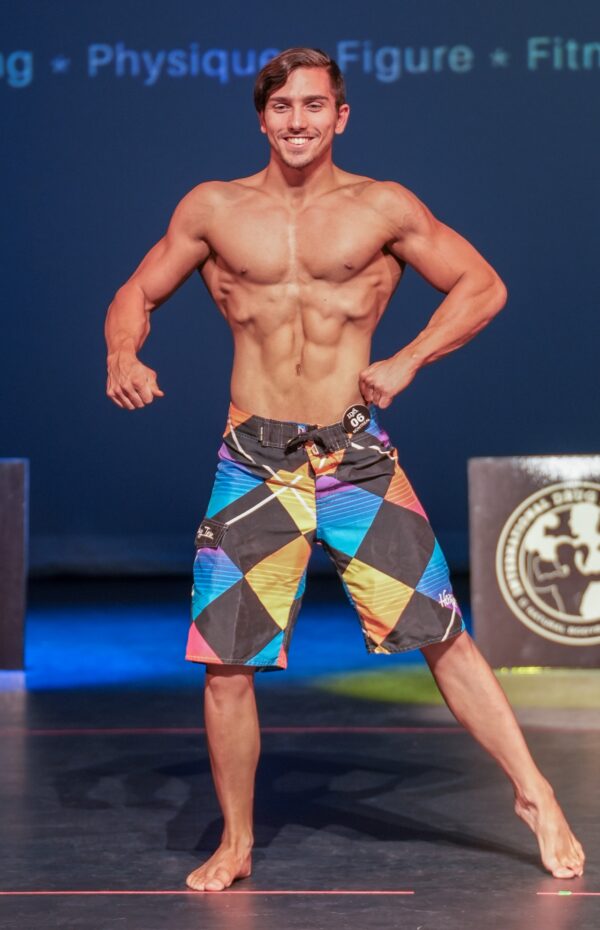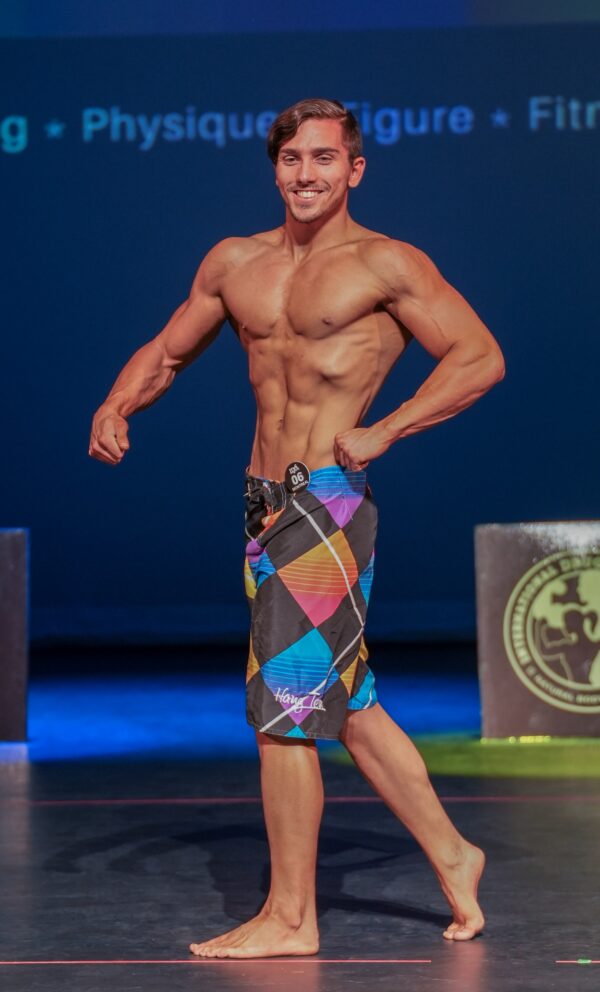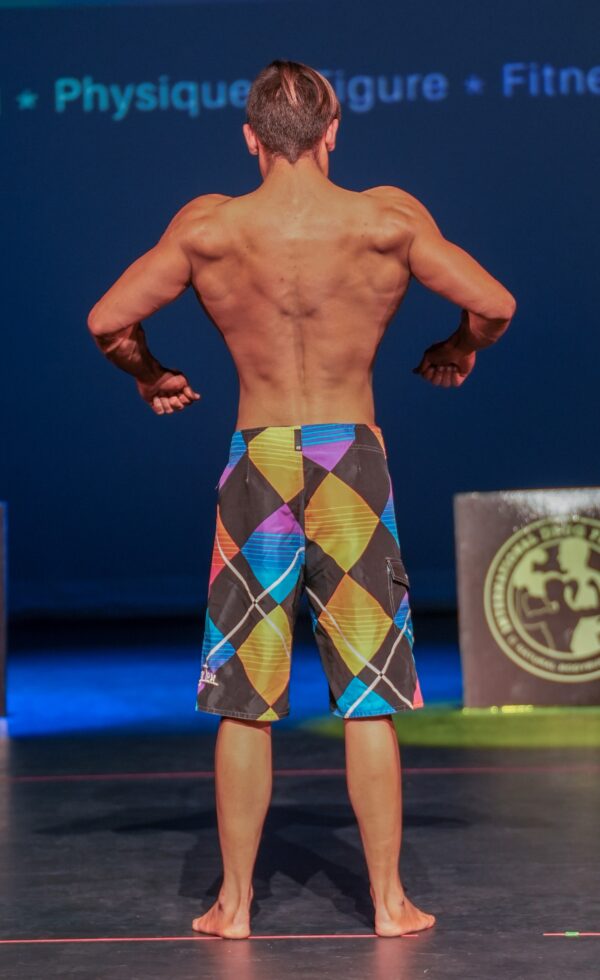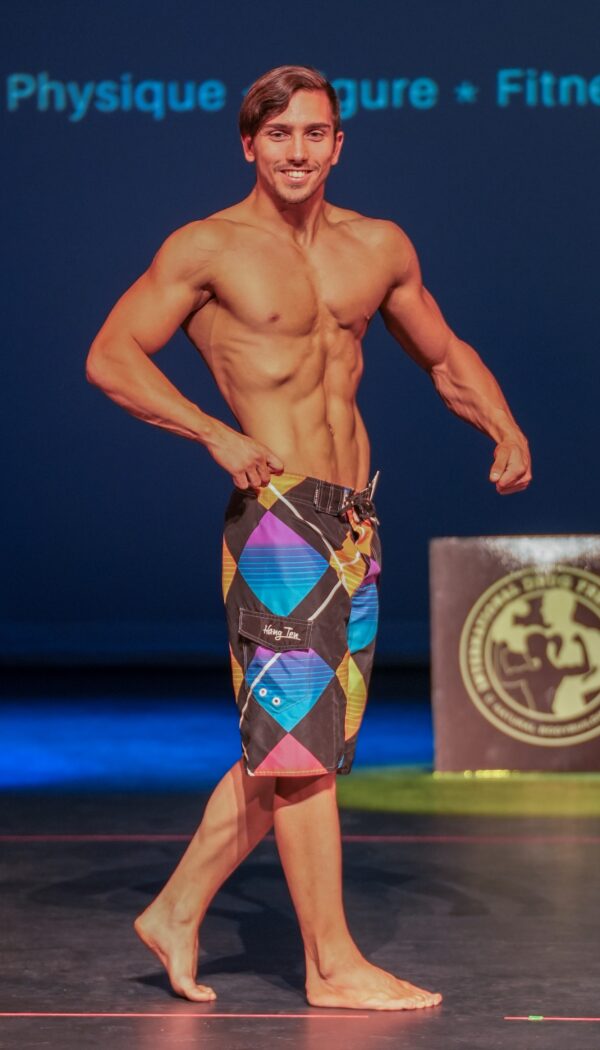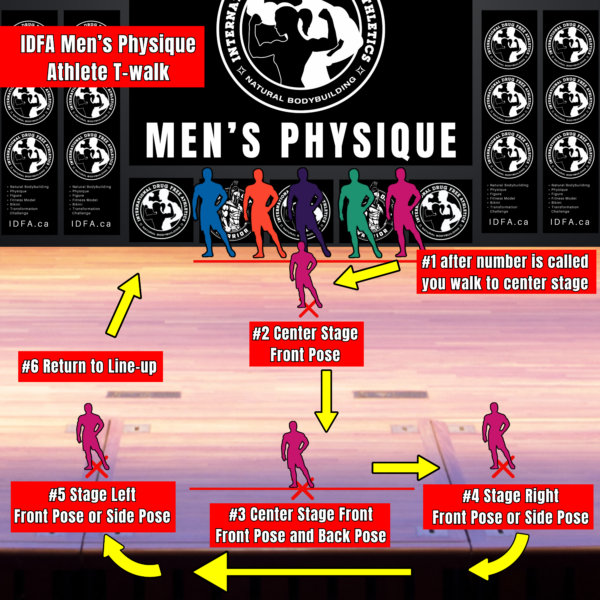This detailed breakdown of the Men’s Physique Division within the IDFA outlines everything an athlete needs to know before stepping on stage. Whether you’re a novice or a seasoned pro, understanding these guidelines is crucial for success in competition.
Is Men’s Physique for You?
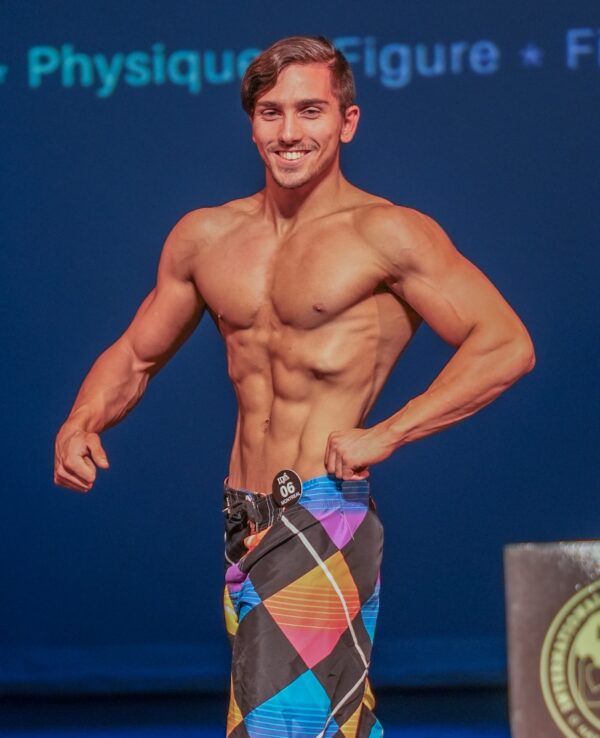 If you have a lean, athletic, and aesthetically pleasing physique, Men’s Physique could be your calling. With broad shoulders, a wide back, striking abs, and a narrow waist, your well-balanced body showcases both upper and lower muscularity.
If you have a lean, athletic, and aesthetically pleasing physique, Men’s Physique could be your calling. With broad shoulders, a wide back, striking abs, and a narrow waist, your well-balanced body showcases both upper and lower muscularity.
You aim for a streamlined look that emphasizes a natural yet sculpted physique, embodying the essence of fitness and health.
Your confidence shines through in your smooth, controlled poses, highlighting your best features with precision. Your smile, eye contact, and overall demeanor exude assurance and poise, enhancing your stage presence and leaving a lasting impression.
Have questions or need more information? We’re here to help. Contact Shaun or join our Free Facebook group, IDFA Room, to connect with fellow competitors and get inspired.
Athlete Attire: What do you Wear?
Posing Suit:
- Athletes should wear conventional board shorts in any color. The length should be between 3 inches above the knee and at the knee, with the fit designed to accentuate your physique.
- Must be in good taste and approved by the IDFA prior to competition.
- Worn during both the Judging round and Presentation & Awards round.
- All suits will be checked at Athlete Registration/Check-in.
Jewellery:
- Only small earrings and wedding rings are permitted.
Classes: Where do you Fit?
Novice Men’s Physique:
- Competitors who have not placed in the top 3 in an Open class equivalent in another organization or in the Novice class in an IDFA sanctioned event.
- If more than 10 competitors, there will be 2 classes divided based on height.
Open Men’s Physique:
- Competitors who have placed top 3 in the Novice class in an IDFA sanctioned event or in the Open class equivalent in another organization.
- If more than 10 competitors, there will be 2 classes divided based on height.
- Winners of the Open class will earn IDFA Pro Status, provided there are at least 3 athletes in the class.
Masters 40+ Men’s Physique:
- Competitor is at least 40 years of age on day of competition.
- One class for all Masters 40+ Men’s Physique competitors.
Masters 50+ Men’s Physique:
- Competitor is at least 50 years of age on day of competition.
- One class for all Masters 50+ Men’s Physique competitors.
Pro Men’s Physique:
- Competitors who hold a current IDFA Pro Card
- Competitor has earned Pro Status in a recognized natural organization and has been approved to compete in the IDFA Pro Division. The IDFA must approve this prior to competition.
- One class for all Pro Men’s Physique competitors.
Crossovers: Competing in Multiple Classes & Divisions
- Masters 40+: Competitors in the Masters 40+ class can also enter the Novice and/or Open classes.
- Masters 50+: Competitors in the Masters 50+ class have the option to enter the Novice and/or Open classes. Additionally, they can also compete in the Masters 40+ class.
- Novice Competitors: Novice competitors may be allowed to enter the Open class as well, but this requires approval by the Promoter on a show-by-show basis.
- Multiple Divisions: Athletes are allowed to enter more than one Division in the same show. For example, you can compete in both Bikini and Fitness Model, or in Men’s Physique and Men’s Classic Physique at the same event.
This flexibility allows you to showcase your physique across different divisions and classes, maximizing your competitive experience and opportunities to shine on stage.
Judging Criteria: How will you be Judged?
Judges will assess:
- Judges are looking for a lean, fit, and muscular physique that is balanced and aesthetically pleasing.
- Competitors should not have the extreme muscle mass or leanness that is required for the bodybuilding division.
- Judges are looking for a small waist and a strong V-taper from the shoulders to the obliques.
- Competitors are also judged on their grooming and overall aesthetic presentation.
Judging Round: What do you have to do on stage?
Competitors will:
- Line up in numerical order, facing the front in a Front pose (either hand on hip).
- Execute a series of quarter-turn comparisons as directed by the Head Judge.
Mandatory Poses:
Front Pose
- Place one hand on your hip, either the left or right, depending on your preference.
- Let your opposite arm hang naturally at your side, keeping it close to your body—not too far out.
- Both feet and hips should face forward. A slight outward angle of the feet is allowed.
- Extend one leg to the side, ensuring your feet remain parallel.
- Keep your lats open and flared to highlight the V-taper, accentuating your upper body’s width and symmetry.
Side Pose – Left
- Your hips and feet should face the side of the stage, with your head turned toward the judges.
- Rotate your shoulders slightly toward the judges to accentuate your V-taper.
- The right arm, which is facing away from the judges, should hang naturally down at your side.
- The left hand, closest to the judges, should be placed on your hip.
- The left foot (closest to the judges) should be flat on the stage, while the right foot (toward the back) should be spiked to show off the calves.
Back Pose
- Competitors will face the back of the stage.
- Both feet should remain flat on the floor, parallel to each other, with a slight outward angle of the toes allowed.
- Feet should be positioned about shoulder-width apart or closer.
- Flare your lats to display the V-taper. You may choose to place one hand on your hip if it enhances your presentation.
Side Pose – Right
- Your hips and feet should face the side of the stage, with your head turned toward the judges.
- Rotate your shoulders slightly toward the judges to accentuate your V-taper.
- The left arm, which is facing away from the judges, should hang naturally down at your side.
- The right hand, closest to the judges, should be placed on your hip.
- The right foot (closest to the judges) should be flat on the stage, while the left foot (toward the back) should be spiked to show off the calves.
Presentation & Awards Round
Competitors will:
- Line up in numerical order, on the back line, facing the audience in a Front Pose (either hand on hip).
- Each competitor will be introduced for their Athlete T-walk.
- Men’s Physique Athlete T-walk: Once the competitor is introduced they will walk in front (and Center) of the line-up, complete a Front Pose, then walk towards the front of the stage (Front Center), complete a Front Pose and Back Pose, then head to their left to the far end of the stage (Stage Right), complete either a Front Pose or a Side Pose, then head to the far right of the stage (Stage Left), complete a Front Pose or Side Pose, and then return to their original position in the line-up.
- This is an Athlete T-walk and not a posing routine. The poses will be Men’s Physique poses, not bodybuilding style poses.
- The Athlete T-walk should take about 30 seconds per competitor, providing an opportunity to display your physique and confidence to the judges and audience.
Awards Presentation:
After the presentation round for each competitor in the class is completed:
- All competitors in the class will exit the stage behind the curtain. If there are 5 or fewer competitors in the class, they will remain on stage.
- The top 5 competitors will be called back to the stage, in no particular order, to the back line. Awards will be handed out to the top 5 on stage during the show. Note: Every athlete in the class will get an official placing on the IDFA website after the show.
- The awards presenter will place a medallion around your neck as you line up on the front line of the stage. Competitors will be arranged in order from 5th to 1st place. The top 5 placements will be officially announced on stage.
- After the awards are handed out, a photo will be taken of the Top 5, then the Top 3, and finally, a solo photo with the Winner.
- Note: For the Pro Classes we will Official place every one of them on the stage at the event. For example, if we have 8 Pro competitors, we will place them 8th to 1st place at the show with medallions.
Award Details:
- Amateur: The Top 3 will receive Large IDFA Custom Medallions, while 4th and 5th place will receive smaller IDFA medallions.
- Pro: The Top 10 will receive Large IDFA Custom Medallions. Cash prizes may be awarded, and these will be announced prior to the event.
This is the process for awarding competitors in all classes, ensuring a clear and organized presentation.
JUDGING – ONLINE COMPETITIONS
Submitted Competitor Photos and Videos will be compared against the Photos and Videos of the other competitors in your class. Official IDFA Judges will be individually and privately going over all of the competitor Photos and Videos and comparing them and ranking them from 1st place to the final placing and submitting them to the IDFA as their official placings just as we do at our Live Competitions. All competitors will be placed.
PHOTOS and VIDEO SUBMISSIONS – ONLINE COMPETITIONS
We will need a photo of each mandatory pose. We will also need a VIDEO of you performing all the mandatory poses.
For the Photos and Video make sure we see your entire body from the bottom of your foot to the top of your head. You can not edit or use filters on the Photos and Video. For the Video, if you are using your phone, hold it upright (or vertically). We will be putting together a Contest Coverage and Results video for every online competition.
To validate the date we will need one photo of you holding a piece of paper with the code word on it. We will be emailing the code word out to all the athletes late the evening before the online competition.
Send your Photos and Videos submissions to info@idfa.ca. We can also use sending files sites such as DropBox, Wetransfer, etc. If you prefer another method for sending Photos and Videos please email Shaun at info@idfa.ca. The main file sharing programs we use are Dropbox and WeTransfer.
If you have any questions please message Shaun at info@idfa.ca.
This comprehensive guide ensures that you’re fully prepared for every aspect of the competition, from attire to posing and judging criteria. Whether you’re just starting or aiming for the Pro division, this information will help you present your best self on stage.

